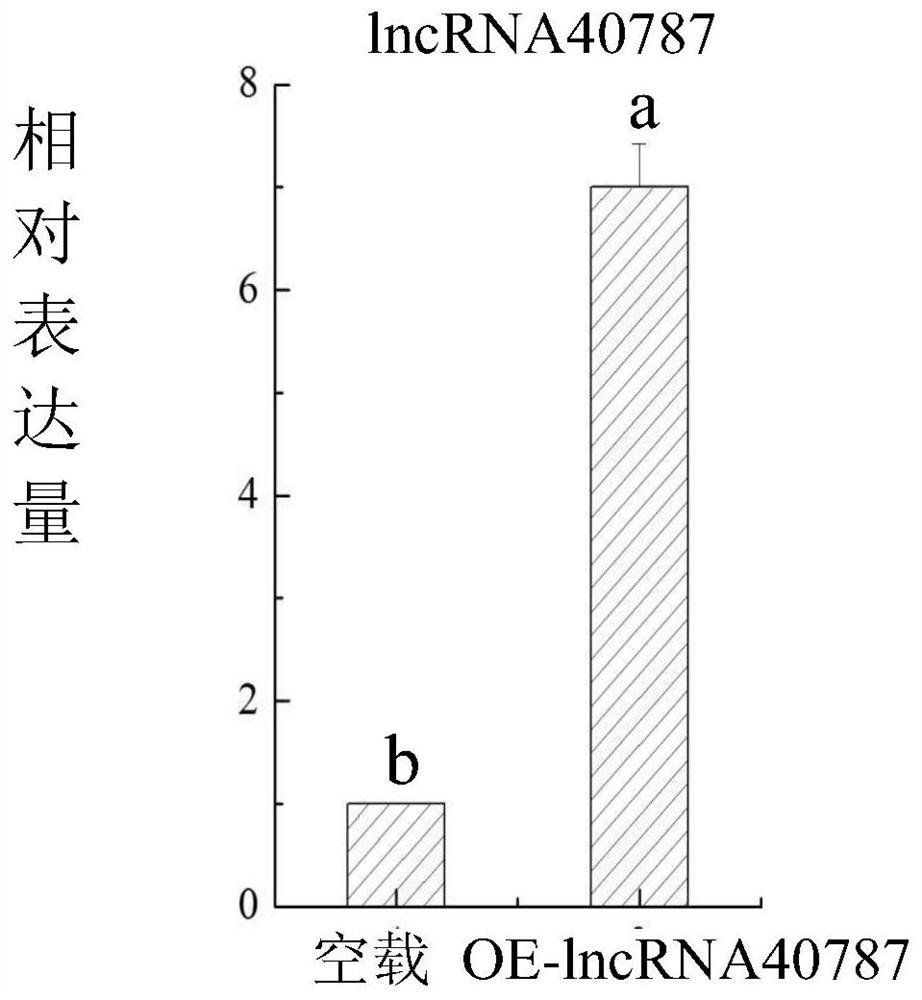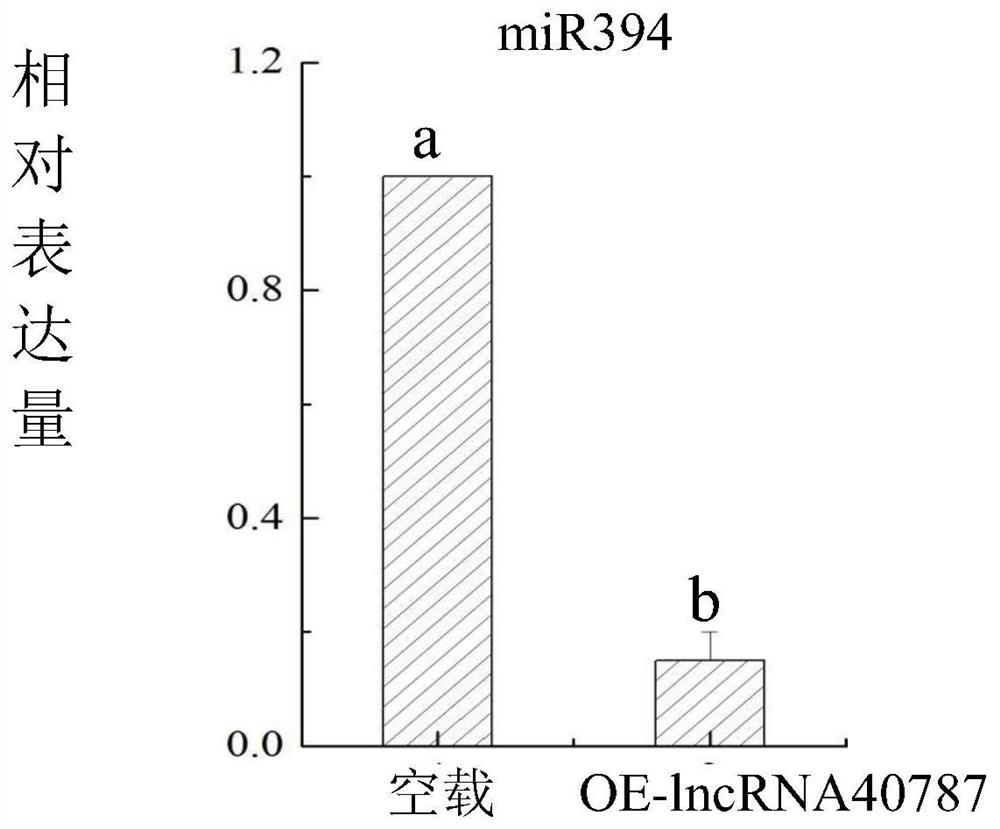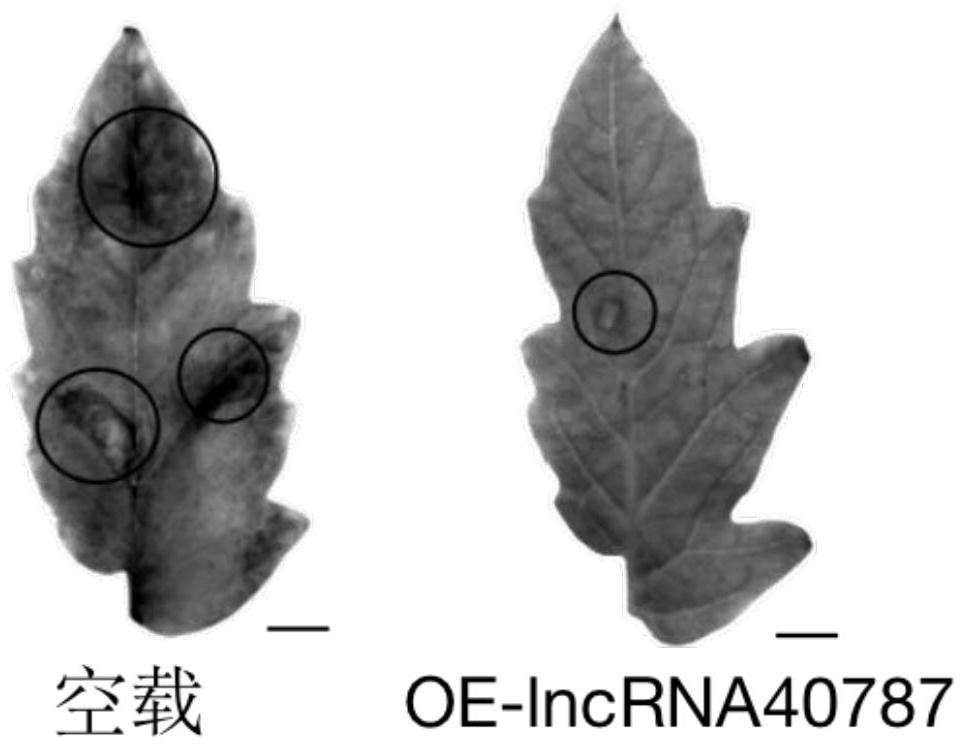Tomato late blight resistant long-chain non-coding RNA-lncRNA40787 as well as cloning method and application method thereof
An rna-lncRNA40787, long-chain non-coding technology, applied in the field of plant genetic engineering, can solve problems such as specific relationships and regulatory methods that have not been reported, and achieve the effects of enhanced resistance, decreased expression, and excellent effect
- Summary
- Abstract
- Description
- Claims
- Application Information
AI Technical Summary
Problems solved by technology
Method used
Image
Examples
Embodiment 1
[0029] Example 1: Cloning of tomato anti-late blight long non-coding RNA-lncRNA40787
[0030] 1. Extraction of Tomato Total RNA
[0031] (1) Put the sample into a mortar, add liquid nitrogen and grind it fully to powder.
[0032] (2) Take an appropriate amount of powder, put it in a 1.5mL RNase / DNase Free centrifuge tube, and quickly add 1mL pre-cooled Trizol at the same time, shake well, and let stand at room temperature for 5min.
[0033] (3) Add 200 μL of chloroform to the centrifuge tube, shake well, let stand at room temperature for 5 minutes, and centrifuge at 12,000 r / min at 4°C for 15 minutes.
[0034] (4) Transfer the supernatant to a new centrifuge tube, add an equal volume of isopropanol, mix gently by inversion, let stand at -20°C for 20min, then centrifuge at 12000r / min at 4°C for 10min.
[0035] (5) Discard the supernatant, add 1 mL of pre-cooled 75% ethanol, wash the precipitate, and centrifuge at 12000 r / min at 4°C for 5 min.
[0036] (6) Carefully discard t...
Embodiment 2
[0063] Example 2: Construction of recombinant expression vector for tomato late blight resistance long non-coding RNA-lncRNA40787
[0064] 1. Enzyme digestion of pMD-18T-lncRNA40787 plasmid
[0065] The pMD-18T-lncRNA40787 plasmid was double digested with BamHI and SacI (purchased from Takara), and the target fragment, namely a small fragment, was recovered. The enzyme digestion reaction system and method are as follows:
[0066]
[0067] Digested at 37°C for 6 hours, and detected the digested products by 1% agarose gel electrophoresis.
[0068] 2. Double digestion of pBI121 plasmid
[0069] The pBI121 plasmid was double digested with BamHI and SacI, and the pBI121 fragment, that is, the large fragment, was recovered. The reaction system is as follows:
[0070]
[0071] Digest at 37°C for 6 hours, and detect the digested product by 1% agarose gel electrophoresis.
[0072] 3. The target fragment is connected to the pBI121 vector
[0073] T4 DNA ligase (purchased fro...
Embodiment 3
[0076] Example 3: Application of tomato long-chain non-coding RNA-lncRNA40787 against late blight
[0077] l. Preparation of pBI121-lncRNA40787 Agrobacterium engineering bacteria
[0078] (1) Add 2.0 μL of the pBI121-lncRNA40787 plasmid to 100 μL of Agrobacterium competent cells, mix well, bathe in ice water for 10 minutes, and quickly transfer to liquid nitrogen to freeze for 5 minutes;
[0079] (2) Place the frozen mixture in a water bath at 37°C for 5 minutes, add 1 mL of fresh YEB medium, and place it in a constant temperature shaker at 28°C (180 rpm) for 3 hours;
[0080] (3) After centrifuging the above bacterial liquid, suck off 1 mL of the supernatant, blow and mix the remaining 100 μL bacterial liquid, and evenly spread it on the YEB solid medium (containing 100 mg / L streptomycin, 100 mg / L rifampicin and 50 mg / L kanamycin), cultured at 28°C for 36h;
[0081] (4) PCR detection of Agrobacterium engineering bacteria
[0082] The colony obtained by antibiotic selectio...
PUM
 Login to View More
Login to View More Abstract
Description
Claims
Application Information
 Login to View More
Login to View More - R&D
- Intellectual Property
- Life Sciences
- Materials
- Tech Scout
- Unparalleled Data Quality
- Higher Quality Content
- 60% Fewer Hallucinations
Browse by: Latest US Patents, China's latest patents, Technical Efficacy Thesaurus, Application Domain, Technology Topic, Popular Technical Reports.
© 2025 PatSnap. All rights reserved.Legal|Privacy policy|Modern Slavery Act Transparency Statement|Sitemap|About US| Contact US: help@patsnap.com



